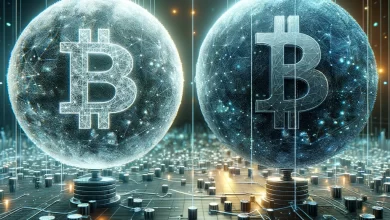From a Drug Peddler To Elon Musk: How Is Satoshi Nakamoto Still Anonymous After a Decade-Long Search
“I’ve moved on to other things. It’s in good hands with Gavin [Andresen] and everyone” — this message was sent by Satoshi Nakamoto to a developer Mike Hearn on April 23rd, 2011. It is considered to be the last or one of the last confirmed contacts with the creator of Bitcoin before his, her, or their disappearance.
However, the hunt for Satoshi began a bit earlier. On December 12th, 2010, Nakamoto left their last post on bitcointalk.org forum, reading that Bitcoin is still vulnerable to DoS-attacks. That was the moment people started asking if Satoshi is a real person.
Since then, the search for Bitcoin’s creator keeps on going. Every year the community comes up with new versions, but nobody got closer to answers. Were they really a libertarian? Did they create Bitcoin with politics in mind? Are they, in fact, Japanese? We don’t know.
What we do know is that Satoshi’s disappearance was decisive for Bitcoin and its history. The community was left without a leader to dictate the course of action. Meanwhile, the protocol faced an excruciating test for censorship resistance, which it passed successfully.
To sum up the findings of this almost a decade-long quest, ForkLog journalists have put together all the theories about Nakamoto’s person, from plausible to the most insane ones. We promise that you’ll find this conundrum as fascinating as we did.
Eastereggs In Plain Sight
The community is confident that Satoshi Nakamoto is a pseudonym. One of the Japanese forum users noted that it is not customary for Japanese to put the first name before the last name, as Nakamoto did. Moreover, the Bitcoin creator had never used Japanese words, which made the truth seekers believe that he’s not Japanese. Yet, there were speculations that Satoshi wanted people to make this conclusion.
In Japanese Satoshi means “wise” or “clear mind.” –Naka can mean “inside” or “relationships,” while -moto is “origin,” “base,” “foundation.” Together it means something along the lines of “clear mind inside the foundation.”
Some enthusiasts suggested a more trivial explanation: Satoshi’s name can be formed by the names of four technology companies SAmsung, TOSHIba, NAKAmichi, and MOTOrola. However, this particular assumption seems far fetched.
April 5th, 1975. This is the birth date from Nakamoto’s profile on P2PFoundation. Some people found hidden meanings here as well. On April 5th, 1933, the US President Franklin D. Roosevelt signed the Executive Order 6102 “forbidding the hoarding of gold coin, gold bullion, and gold certificates within the continental United States.” It was officially in force until December 31st, 1975, just a day before 1975.
A swiss programmer Stefan Thomas discovered that Nakamoto never posted anything between 05:00 and 11:00 GMT, even on weekends. This led Thomas to believe that Nakamoto lives in the UK. This version is backed by Nakamoto’s perfect English and the usage of words such as “bloody,” “optimise,” and “colour,” which are typical for the British. Satoshi has also included an excerpt from an article by the British outlet The Times, highlighting the possibility of the second bailout for the UK banks, into the genesis block of Bitcoin.
It is possible that Satoshi left all these clues deliberately to hide his tracks. According to a linguist Adam L. Penenberg, British English was a disguise. His investigation led to Neal J. King, an educated and well-read man, who reviewed 46 books on Amazon, including astronomy, biology, cryptography, linguistics, literature, mathematics, philosophy, and physics. Later, King refuted any involvement with Bitcoin development.
Penenberg also claims that programmers Vladimir Oksman and Charles Bray were competent enough to create such a system, but both dismissed the claims.
Laszlo Hanyecz, the programmer who bought pizza for 10 000 BTC in 2010, once said that Bitcoin source code is too good to be made by one person. Laszlo believes that Satoshi is unlikely to be real.
Bruce Kleinman, the author of “The Bitcoin Tutorial,” agrees with this version. He is confident that it is impossible to find somebody who would know cryptography, network architecture, software architecture, and cybersecurity simultaneously.
Notably, one of the most extraordinary members of the crypto community John McAfee stated that Bitcoin was developed by an Indian team. Considering McAfee’s reputation this claim doesn’t appear credible.
One of the people who disagree with the concept of Satoshi being a group of people is Adam Back, the creator of Hashcash and CEO of Blockstream. He highlighted the consistency of coding and Satoshi’s writing style in letters and documents. In fact, for a while Back was considered to be the real Satoshi. He created Proof-Of-Work prototype back in the 1990s and was cited in Bitcoin white paper. Back himself disagreed with the claims and urged the community to stop the hunt.
In 2011, a famous whitehat hacker Dan Kaminsky decided to break Bitcoin. Being the one who discovered a critical vulnerability in DNS protocol, Kaminsky was confident of his skills. He designed nine approaches to attacking the protocol, but each of them failed.
“The way the whole thing was formatted was insane. Only the most paranoid, painstaking coder in the world could avoid making mistakes,” he said.
Dan Kaminsky noted that Satoshi is “a world-class programmer, with a deep understanding of the C++ programming language,” who understands economics, cryptography, and peer-to-peer networking. He concluded that Satoshi is either a team of people or a genius.
The same year, The New Yorker journalist Joshua Davis started looking for Satoshi among the visitors of the Crypto 2011 conference. He found nine people from Britain and Ireland. Six of them, a group from Bristol University, didn’t have experience with P2P networks. The other two had no history with large software projects. The last candidate caught the journalist’s attention. It was Michael Clear, a graduate student in cryptography at Trinity College in Dublin.
The best student of 2008, Micheal developed software for Allied British Banks, authored a detailed academic document about P2P technologies, and was well-versed in C++. When asked about the financial crisis, he said that it could’ve been avoided.
In the end Clear denied any connection to Bitcoin development. However, he told Davis that a Finnish researcher Vili Lehdonvirta could be Nakamoto. When contacted by the journalist, Lehdonvirta laughed and said that he’s not.

“I would love to say that I’m Satoshi, because bitcoin is very clever, but it’s not me,” the researcher said.
Lehdonvirta added that he has no experience in cryptography whatsoever and his knowledge of C++ is very limited.
Even Elon Musk was once suspected to be Satoshi because of his C++ skills. The entrepreneur denied all claims. In his later statements Musk acknowledged the advantages of Bitcoin over paper money.
According to another popular conspiracy theory, Bitcoin was created by a group of developers from the National Security Agency (NSA). An article from 1996 called “How To Make A Mint: The Cryptography Of Anonymous Electronic Cash” by the Agency researchers allegedly supports this version. The community finds this theory implausible, as the NSA’s description has more similarities the eCash system designed by David Chaum.
How to spot a crypto-charlatan:
somebody posting this 1996 paper as evidence that somebody at NSA was thoroughly describing Bitcoin 12 years earlier (when indeed they were just superficially describing Chaum’s bank-based Ecash 6 years later)https://t.co/hJ5ISK5YFA
— Giacomo Zucco [I identify as #ProUDI] (@giacomozucco) August 17, 2019
Some people point out the fact that SHA-256 was developed by the NSA, although the best cryptographers have been using it for over 15 years and didn’t find any backdoors.
As a bonus to the spy theme, in 2018 the CIA stated that they “can neither confirm nor deny” they have information about Satoshi’s identity. The particular phrasing “can neither confirm nor deny” is a so-called Glomar response government agencies use when they don’t want to disclose information.
In 2017, entrepreneur and investor Alexander Muse claimed that the NSA utilized PRISM and MUSCULAR surveillance systems to deanonymize Nakamoto. Allegedly, the Agency also employed stylometry: Satoshi’s texts were compared with trillions of texts by other authors on the Web. His code was analyzed as well. Muse says that the NSA has got a digital “fingerprint” that identifies the texts written by Nakamoto and it was already applied in further search among letters and chats of one billion people.
Curiously, there are no women or non-white people among the candidates for Satoshi’s role. All of the suggested versions present the Bitcoin creator either as a male or as a group of people.
Nakamoto’s Face Or the Return Of the Creator

In 2014, Newsweek published arguably the most hyped investigation into Nakamoto’s identity. The journalists have found a Japanese-born Californian called Dorian Satoshi Nakamoto. At the time Dorian was 64 and refused to talk to the press.
“My brother is an asshole. What you don’t know about him is that he’s worked on classified stuff. His life was a complete blank for a while. You’re not going to be able to get to him. He’ll deny everything. He’ll never admit to starting Bitcoin,” said Dorian’s brother.
The man was indeed a mathematician, a physicist, and a computer engineer who worked on secret projects for private companies and the Department of Defense. His former colleague recalled how during one of the interviews Nakamoto called the interviewer an idiot and then proved it.
A famous Bitcoin developer Gavin Andresen told Newsweek that Satoshi might insult one’s intellectual capabilities and then stop talking to them entirely, should they make an honest mistake. Both Californian Nakamotos didn’t have this trait.
Andresen also believed that Bitcoin source code was made by one person and described Satoshi’s coding style as “old-school.” This fact pointed towards an older Satoshi.
Yet, in the end, Dorian Nakamoto, who unwillingly became the face of the Bitcoin creator, disproved all allegations:
“I did not create, invent or otherwise work on Bitcoin. I unconditionally deny the Newsweek report. The first time I heard the term ‘bitcoin’ was from my son in mid-February 2014.”
He added that unwanted attention to his persona is hurting his family and asked to respect privacy.

Notably, the next day after the article was published, Nakamoto’s profile on P2PFoundation came back to life to post just one message:
“I am not Dorian Nakamoto.”
It isn’t clear if it was the real Satoshi or the profile was hacked. One of the possible interpretations is that it was an attempt to protect the privacy and property of an innocent person.
Satoshi’s P2PFoundation profile woke up again at the end of November, 2018. This time it posted the word “nour” and added a friend called Wagner Tamanaha
However, it is also known that a certain hacker named Jeffrey got access to [email protected] and posted on P2PFoundation back in 2014. Jeffrey claimed that he has information on Satoshi’s real identity and is willing to sell it.
Another “return of Satoshi” happened at the end of 2015, when Bitcoin developers received an email from [email protected] — an address previously associated with Nakamoto. The topic was “Not this again” and the message said:
“I am not Craig Wright. We are all Satoshi.”
Faketoshi

Australian entrepreneur and scientist Craig Steven Wright is probably the only person in the world, who vigorously tries to prove that he created Bitcoin in 2008.
This version probably appeared in an investigation by The Wired published on August 12th, 2015. The article reads:
“Either Wright invented bitcoin, or he’s a brilliant hoaxer who very badly wants us to believe he did.”
The article also mentions a computer computer forensics analyst David Kleiman. It calls Kleiman “a close friend and confidant” with whom Wright has discussed the creation of Bitcoin and maybe even the launch of the network. Interestingly, one of the first Bitcoin developers Jeff Garzik thinks that Kleiman is, in fact, the creator of the first cryptocurrency.

The same year, The Wired published one more article with a set of facts speaking against the former version. According to the article, two PGP-keys that were meant to prove that Wright and Satoshi are the same person were fake. It also mentioned that Wright may not have earned his PhD, as Charles Sturt University’s statement says it never handed Wright any degrees.
On May 2d, 2016, Craig Wright officially announced that he is Satoshi Nakamoto and BBC, Economist, and GQ have already received the proof. Some members of the community, including the creator of Bitcoin Foundation John Matonis and allegedly Gavin Andresen, have agreed that the claim is true.
However, very soon the community started doubting. Allegedly Wright has signed a message with cryptographic keys that only Satoshi could use. The keys in question are the private keys that were tied to a block containing the first 10BTC transaction from Satoshi to a computer scientist Hal Finney. Hal retired because of the progressing amyotrophic sclerosis and died in 2014.
Shortly after, Andresen said that theoretically Wright might’ve fooled him, but continued to support Wright’s claim. In 2016, Andresen stopped working on Bitcoin Core client and supported Bitcoin Cash fork in 2017.
Wright himself never signed messages with Satoshi’s private keys again. Neither did he make transactions from Nakamoto’s addresses. Craig Wright supported Bitcoin Cash and later headed its fork Bitcoin SV.
Just this summer, under oath Wright claimed that he is Satoshi Nakamoto. He said that he left the project out of shame and accused famous developers and members of the community of using Bitcoin to spread child pornography and drugs. Witnesses say that he even cried in the courtroom, although it is not included in the transcript. That day he also claimed that he first met Dave Kleiman in August, 2010. It contradicts the story where Craig and Kleiman discussed the creation of a cryptocurrency back in 2008.
All in all, the version of Craig Wright, also known as Faketoshi, is quite dubious.
The Creator Of Bitcoin Prototype

The most plausible version is that Bitcoin was created by cryptographer Nick Szabo. Enthusiastic conspirologists may have noticed a whole lot of clues.
Back in 2013, Skye Grey, a researcher who was looking for Satoshi, named several reasons as to why he thinks Szabo is Satoshi:
- Text analysis revealed similarities in writing style (only 0.1% of cryptographers match).
- Several months prior to the launch of Bitcoin, Nick was looking for partners to work on Bit Gold. There has been no news about Bit Gold since then.
- Satoshi’s white paper doesn’t refer to Szabo’s work, while mentioning other projects, less similar to Bitcoin.
- While being interested in such a decentralized cryptocurrency for a decade, Szabo seemed to have no reaction to Bitcoin whatsoever.
- Shortly after Bitcoin was announced, Nick modified the timestamps on his projects to make it look like they were released after said announcement.
Subsequently, in a post on Bitcointalk Satoshi wrote that Bitcoin is a combination of two projects: Wei Dai’s b-money and Szabo’s Bit Gold.
Notably, in the 90s, Szabo also invented the concept of smart-contract that was implemented only a decade later. If he was the real Satoshi, it would at least be logical. Szabo himself denied everything.
Black Market Cryptographer
Another investigation led journalists to Paul Solotshi Calder Le Roux, a 46-year old programmer with extraordinary career choices: drug and arms dealing, gold smuggling, money laundering, and even working for the US Drug Enforcement Administration (DEA). Since 2012, Paul has been in jail in the US for organizing six assassinations.
In 1999, he developed data encryption software called E4M for the DEA. Additionally, Paul may be involved with the creation of an on-the-fly encryption utility TrueCrypt.

Le Roux is also mentioned in the documents related to the Kleiman vs. Wright court case. Craig Wright was allegedly informing the secret services and helped find the potential Satoshi.
Some people suggest that after Le Roux was arrested, Wright used Kleiman to get partial access to Satoshi’s wallets. They think that Wright’s business partner Calvin Eire has built several data-centers to break Paul’s passwords encrypted with TrueCrypt.
Simultaneously, Paul Solotshi knows C++ and his writing style is similar to Satoshi’s. He also authored a manifesto containing ideas similar to those of Bitcoin, including the emphasis on strong cryptography as a way to protect personal rights.
This version is also supported by a curious forum post from 2002. It described a concept for “virtual P2P baking” with some similarities to Bitcoin. The author’s IP led to the Netherlands where Le Roux resided for some time.
This version may look sketchy, but it is definitely the most epic of all. Could Satoshi be a criminal?
Pakistani Numerologist
A newcomer among potential Satoshi is James Bilal Khalid Caan, a man from Pakistan who currently lives in the UK. Caan’s father was a banker from Pakistanian United Bank Limited (UBL). UBL’s owner also created the Bank of Credit and Commerce International (BCCI). At its peak, the BCCI was the 7th largest bank in the world, but in 1991 the Bank of England decided to shut it down after discovering cases of money laundering, corruption, and other undesired activities.
Caan believes that the real reason behind the BCCI closure is the corruption in regulatory entities. Therefore, Bitcoin is allegedly named after the bank:

To come up with the name “Satoshi Nakamoto” Caan reportedly used methods of ancient Chaldean numerology and combined his childhood moniker “Shaikho”, date of birth, and the name of the Satoshi Sumita, chairman of the Bank of Japan.
Notably, he stored the private keys to his giant wealth of 980 000 BTC on a hard drive in his laptop. The hardware stopped working in 2010 and Caal lost access to the wallets.
Caal says he left Bitcoin development because the system was used by criminals. Craig Wright named the same reason to the court.
Later Caan faced serious health issues, but promised to come back to the community with the new vision. His comeback would be dedicated to Steve Jobs.
The Writer Who Disappeared
Last year, an anonymous author announced a book that would reveal Satoshi’s identity and the people behind Bitcoin. The first excerpt from the book was posted at now defunct nakamotofamilyfoundation.org.
It said that Satoshi began writing about Bitcoin when he was 20. At that time he was working as a researcher for the lab at his university. The author mentions that “Satoshi Nakamoto” is an equivalent of “John Smith” in the US, therefore the pseudonym doesn’t necessarily mean that the creator of Bitcoin is from Japan.
According to the excerpt, Satoshi was interested in the cypherpunk movement since he was 14 and created Bitcoin after seven failed attempts by other people. The author concluded that Satoshi succeeded because he happened to be at the right place at the right time.
After analyzing the published text, Troy Watson and his research team concluded that it might have been made by the real Satoshi, but the promised release didn’t happen.
Other Satoshis
There are quite a few less popular theories about Satoshi’s identity. At different periods, the list of suspects included an Estonian scientist Helger Lipmaa, a Japanese mathematician Shinichi Mochizuki, and a researcher from Texas Dustin D. Trammell.
In 2013 Israeli mathematicians suggested that Bitcoin may have been created by Ross Ulbricht, the founder of Silk Road marketplace. The theory was eventually dismissed.
The list also included big names such as Bram Cohen, the creator of BitTorrent, and Jed McCaleb of MtGox, Ripple, Stellar.
Wei Dai, the creator of the b-money concept, was also suspected of being Satoshi. The documentation for b-money published in 1998 was the first link in Bitcoin white paper. Satoshi learned about it from Adam Back and tried to contact Dai, but didn’t get a response.
The Great Conundrum
As long as there are mysteries, people will try to reveal them. If Bitcoin is to become the new form of money, the questions about its creator will be as relevant as it gets. Who did it? Why? Why did they choose to disappear instead of being rich and famous?
We do not know if the real name of Satoshi Nakamoto will ever be found out by the community. But we do know that Bictoin will keep on working, whether it happens or not.
In some sense Satoshi’s disappearance is the best thing that could happen to Bitcoin, as there could be no cult of personality. All the other challenges are to be solved by the code.
By Nick Schteringard
Source: forklog.media
View original post





